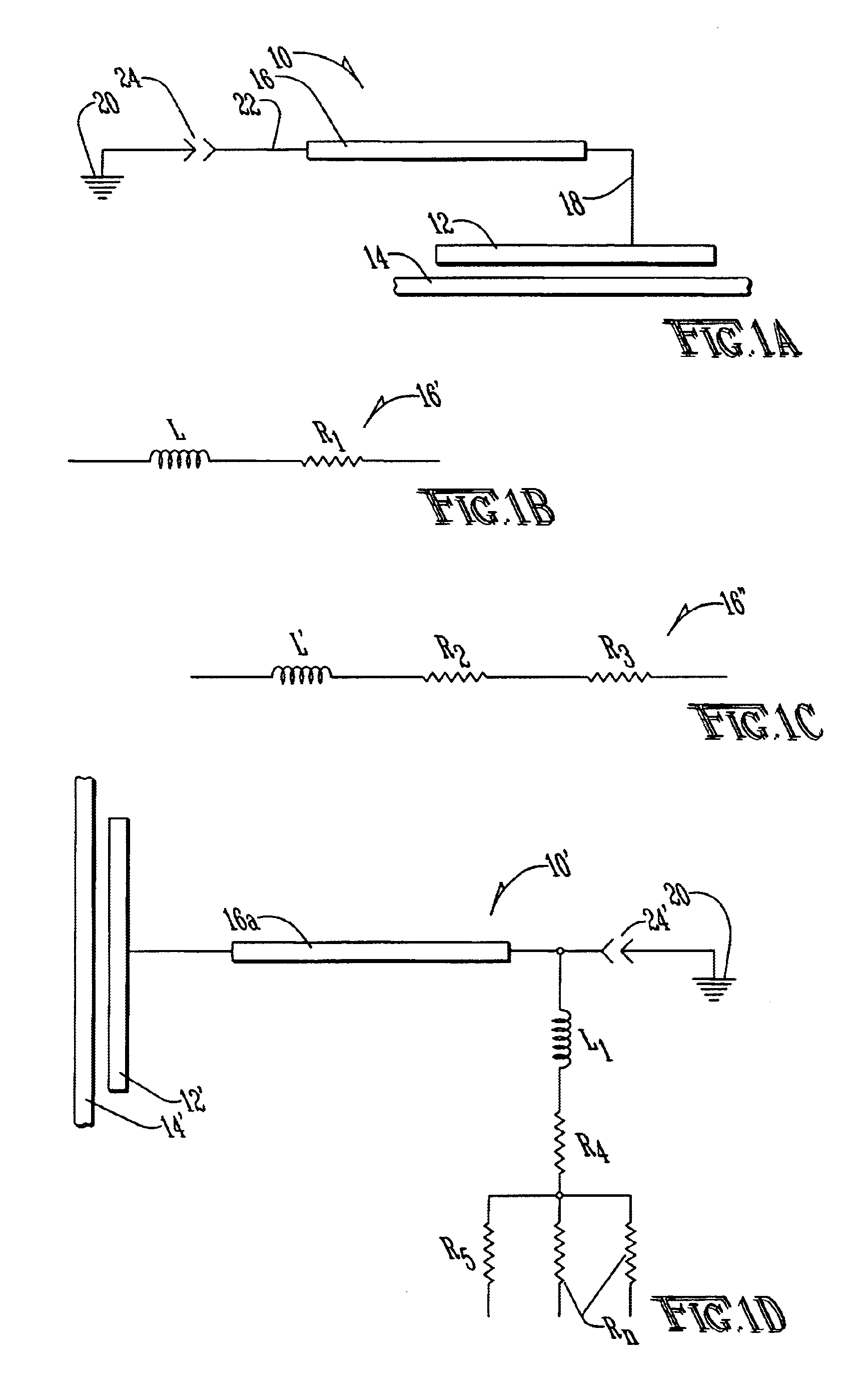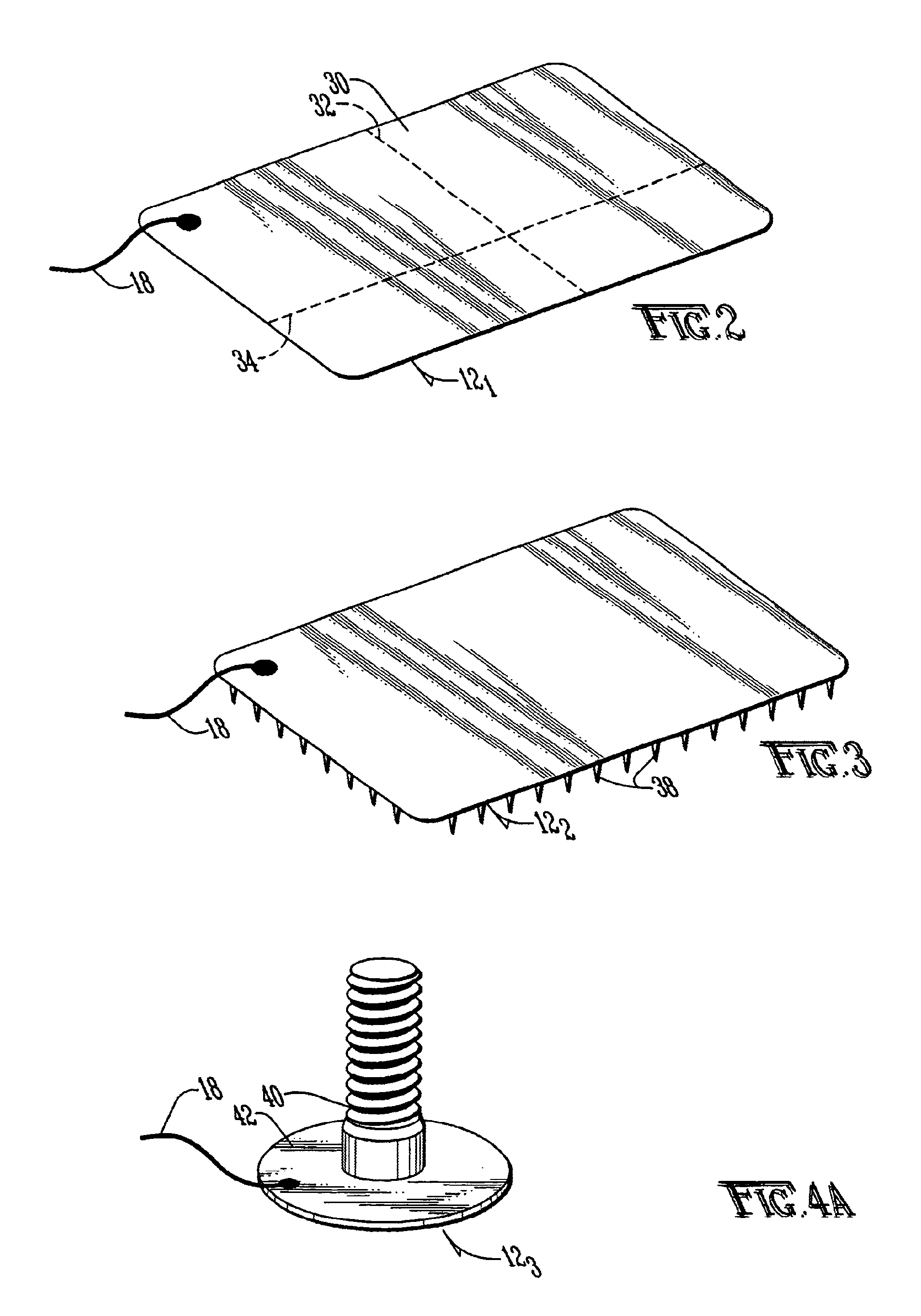This
discharge is very rapid and can be quite violent.
At the least, the charge could cause the equipment to execute an error.
A sufficient number of such discharges may eventually damage the equipment.
For instance, in the
logging industry where chains are lowered by helicopter to loggers waiting on the ground to fasten fresh-
cut timber to them so it could be airlifted to the sawmill or nearby waterway, track access point or the like, the loggers are often reluctant to grab the chain because of a painful shock that may occur as a result of a buildup of static
electricity which will be discharged to ground through their bodies.
However, this is cumbersome.
This solution may be even more cumbersome if the person is an office worker who moves around a great deal.
While many of these devices work well, there are several problem areas not addressed thereby.
This results in drawbacks and disadvantages for such devices when a person or equipment are situated in certain environments or subject to certain conditions.
First, no matter how effective a touch pad is it will be totally ineffective if the person does not use it.
That is, if the person carrying a large ESD charge forgets to touch the touch pad and proceeds to touch a computer, the ESD will discharge through the computer and the touch pad will have been useless.
Furthermore, no matter how effective the ESD protection device is, the current level and / or the change in current level may be so high that either the person or the equipment can be damaged.
Still further, while placing a touch pad on a computer may protect the computer it does not protect the user from the effects of an
electrostatic discharge.
Even a slight electrostatic discharge through a sensitive device may destroy it.
Therefore, significant effort and cost is devoted to eliminating the possibilities of electrostatic potentials in the vicinity of the sensitive
electronics.
This
tethering restraint is inconvenient and not considered suitable for a typical office worker or call center operator.
Applications are similar in the medical field, employing similar tethers and / or foot / shoe connectors also considered impractical for the typical office worker environment.
Today, a new set of ESD problems is emerging in the typical work place or home office environment.
The higher the value of the electrostatic
voltage charge, the greater the distance the charge may `jump` to discharge, and the more `catastrophic` the event to the operator.
For example, there are many documented cases of operators in call centers experiencing a very loud pop or explosion in their ear, ear pain, and even bleeding in the ear as the discharge path appears to take place through the operator's
headset.
Although this sounds like a high value, it is effective for draining static charge as compared to many floorings, adhesives, and especially underfloorings that are considered as insulators and not effective for ESD.
Often, the anti-static carpet appears not to work, even when samples of it test within spec.
Unfortunately re-installation of the carpeting is not feasible in many office environments.
Compounding the problem are the facts that office modules are usually small, further raising the density of furniture and an electrician might be needed to remove module wiring so the units could be disassembled.
As users in the workplace become concerned about ESD, they may be sensitive to every logical source and solution.
For instance, the discharge path may be more surprising or appear worse to the user if it involves the user's ear.
Still in other cases, as explained below, the associated
electronics may potentially make the discharge injury to the person more severe and disturbing by causing a
high current pulse to take place as the discharge event.
In some cases, the associated
electronics may experience physical damage or
processing disturbances due to the operator electrostatic discharge.
However, the electrostatic
voltage on the operator may exceed 15,000 volts-far more than the design tolerance of the
transformer.
The
transformer breakdown may cause a permanent equipment failure.
Other equipment damage or errors can also occur due to the electrostatic discharge event.
This pulse may radiate into nearby circuitry causing errors in
processing or
noise in audio or video circuits.
Although a transformer discharge event has been described above, other similar discharge paths can be envisioned, with similar catastrophic results.
With continued
miniaturization of electronics, the problems may become more severe as circuit component
voltage tolerances become less and
enclosure insulation distances become less.
As the cost of doing business increases, many businesses are reluctant to purchase new original equipment.
This may be especially true on grounding conductors used in modular furniture or office raceway systems since space is limited and conductors are usually just large enough to meet the minimums of the National Electric Code.
ESD discharge currents in the ground path may generate a potential and this is a voltage that may be superimposed on the PC's and network causing disruption or damage by interfering with (relatively minute)
signal voltages.
By a similar
process noise may be caused which is widespread into phone systems such as in a call center or cause
noise in
studio audio and video systems.
 Login to View More
Login to View More  Login to View More
Login to View More 


